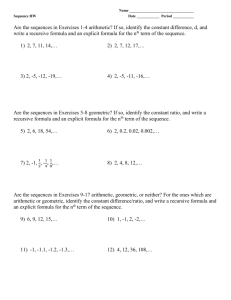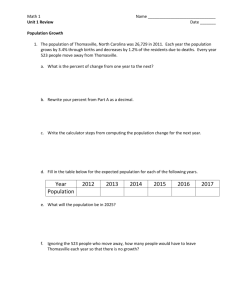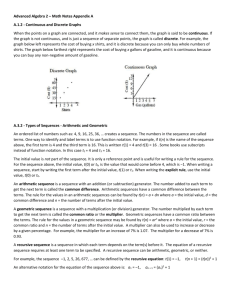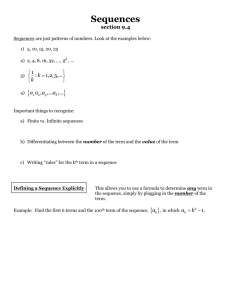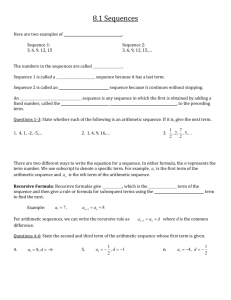Notes
advertisement
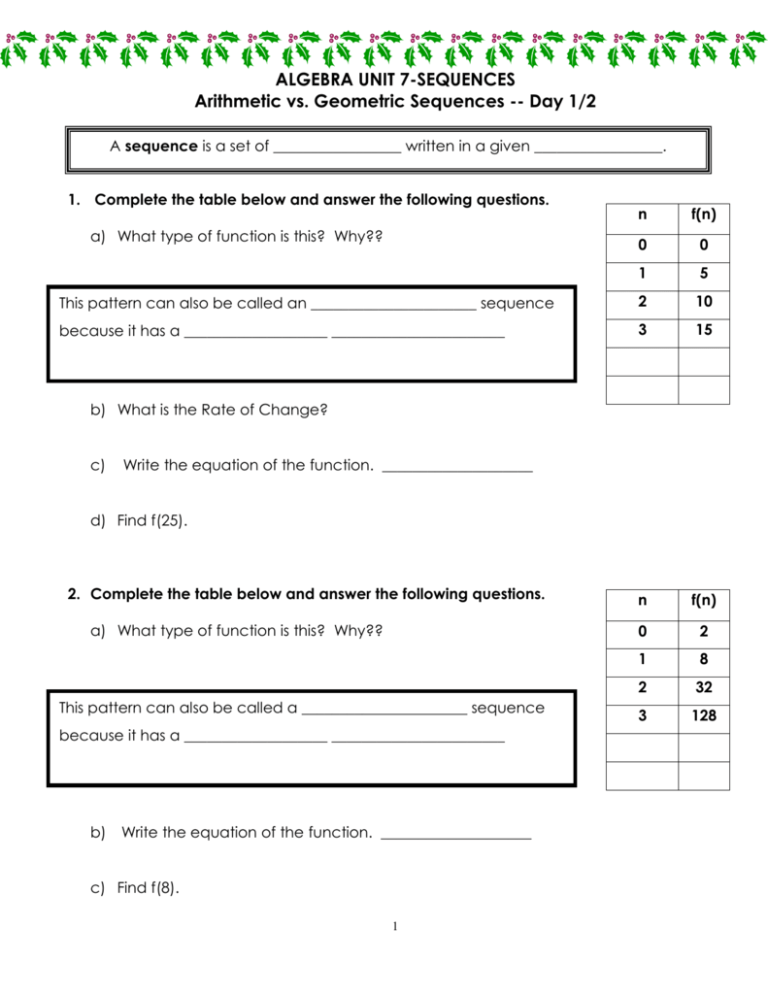
ALGEBRA UNIT 7-SEQUENCES Arithmetic vs. Geometric Sequences -- Day 1/2 A sequence is a set of _________________ written in a given _________________. 1. Complete the table below and answer the following questions. n f(n) 0 0 1 5 This pattern can also be called an ______________________ sequence 2 10 because it has a ___________________ _______________________ 3 15 n f(n) 0 2 1 8 2 32 3 128 a) What type of function is this? Why?? b) What is the Rate of Change? c) Write the equation of the function. ____________________ d) Find f(25). 2. Complete the table below and answer the following questions. a) What type of function is this? Why?? This pattern can also be called a ______________________ sequence because it has a ___________________ _______________________ b) Write the equation of the function. ____________________ c) Find f(8). 1 TYPES OF SEQUENCES: Arithmetic Sequence: a set of numbers in a specific order each having a ________________ _______________________. Represents a _______________________ function. Geometric Sequence: a set of numbers in a specific order each having a ________________ _______________________. Represents an _______________________ function. Given the Sequences below: a) Determine if they are geometric, arithmetic, or neither [Sequences] b) Identify the common difference (d) or common ratio (r) to justify part a. c) Identify the type of function for each sequence 1. 5, 10, 15, 20, 25, … 3. 10, 30, 90, 270, 810, … 2. 64, 32, 16, 8, 4, … 4. 1, 4, 9, 16, 25, … Sequential Notation uses __________________ Notation (an ) to identify each ___________ in the sequence. Similar to Function Notation, f(n). How to Say it How to Use it How it is written as an ordered pair FUNCTION NOTATION f(n) SUBSCRIPT NOTATION an f ______ n a _______ n EX. Given an 2n 1 Find a4 EX. Given f(n) 2n 1 Find f(4) (n, f(n)) (n, an ) 2 Given the following Sequences: a. b. c. d. Identify the terms of the sequence using subscript notation an State the next three terms in the sequence? Describe the type of sequence? State the type of function 1. 2. 4, 1, 6, 11, ... 3, 1, 1 1 , , ... 3 9 How to write a function for sequences in order to find ANY term in the sequence: Identify the type of function that is being represented o Linear (y = ax + b) o Exponential (y = abx) Write a basic equation o Using R.O.C for the linear function o Using first term and r# for the exponential function Create a BASIC SEQUENCE from these equation o Compare the BASIC sequence to the ORIGINAL sequence to determine any ADJUSTMENTS that need to be made to the equation. Apply adjustments to equation and write final version of the equation. 3 EXPLICIT vs. RECURSIVE FORMULAS – Day 2/3 Recall: Given the sequence -2, 2, 6, 10, …, find: a. What are the next three terms? b. What type of sequence is it and why? c. What is the formula of the sequence? d. What type of function does the sequence represent? e. What is the 100th term of the sequence? Ways to Express Sequences: EXPLICIT Formula: A formula that allows computation of _____ term (an). o Example: n an 1 a1 = 7 an = 2n + 5 2 3 4 5 RECURSIVE Formula: A formula that allows any term (an) to be computed from the _______________ term (an-1). You must be given the ___________ term (a1). o Example: n an 1 a1 = 5 a1 = 5 an = an-1 + 4 2 3 4 1. Write the first three terms of the sequence an = 3n – 1. 2. List the next three terms of the sequence: 4 5 a1 = 5 an = 2an-1 + 3 In 3-6, a sequence is described. a) Identify the definition as recursive or explicit. b) Find the first three terms of the sequence. 7. 3. r1 = -4 rn = -3rn-1 4. tn = -6n3 – 48n 5. j1 = 3 jn+1 = (jn)2 6. kn = 12 – 3(n – 1) Write both a recursive and an explicit definition for the following sequence: Recursive 4, 8, 12, 16, 20, … 5 Explicit 8. 9. Given the sequence: 2, 4, 8, 16,… a) List the next three terms of the sequence. b) What type of sequence is this? Why? c) Write an explicit formula for an. d) Write a recursive definition for the sequence. Erin is memorizing words for a vocabulary test. She currently knows 25 words. Each day for the next 6 days, she increased the words memorized by 3. a) Write the sequence for the number of words that Erin memorized for each of the seven days. What type of sequence does this create? b) Write a recursive formula for this sequence. 6 SEQUENCES FORMULAS, Etc. -- DAY 3/4 Arithmetic Sequence: Geometric Sequence: Explicit Formula: Recursive Formula: Sometimes, coming up with formulas on your own can be difficult… So, there are generic formulas you can use! The EXPLICIT formulas will be given to you on the reference table on the final exam. So…you will be given them for any quizzes or tests!! EXPLICIT Formulas for: Arithmetic Sequence, or to find ANY term of an arithmetic sequence, use: an = a1 + (n – 1)(d) However, you must be given the ______ term (a1) and the Common _______________ (d). Geometric Sequence, or to find ANY term of a geometric sequence, use: an = a1 (r)n-1 However, you must be given the ______ term (a1) and the Common ______________ (r). RECURSIVE Formulas for: Arithmetic Sequence: a1 = # an = an-1 + d a1 = 1st Term in sequence an-1 = Previous Term Geometric Sequence: a1 = # an = r an-1 7 For the following sequences, answer… a) b) c) d) e) What are the next three terms? Are the following arithmetic or geometric and why? Write an explicit formula. [Use new formulas from previous page] Write a recursive formula. [Use new formulas from previous page] Use a formula to find the 20th term. 1. 14, 11, 8, 5, … 2. 1, 10, 100, 1000, … 3. 14, 21, 28, 35, … 4. 2, 10, 50, 250,… 5. For #3 above: If the nth term is 294, find the value of n. 6. For the sequence 100, 97, 94, 91, …, find: a) the common difference. b) an explicit formula for the sequence. c) the 20th term of the sequence. 8 7. The local football team won the championship several years ago, and since then, ticket prices have been increasing $4 per year. The year they won the championship, tickets were $20. Write an explicit formula for a sequence that will model ticket prices. What will the ticket price be 10 years after that championship year? 8. Cooper is saving to buy a guitar. In the first week, he put aside $10 that he received for his birthday. In each of the following weeks, he decided he will put aside $8 more than the week before. How much money will he be putting aside in the 7th week? 9. Given the sequence: 4, 12, 36, 108, 324, … a) What is the common ratio? b) Write an explicit formula for this sequence. c) What is the 10th term of this sequence? 10. What is the 8th term of the geometric sequence 125, 25, 5,…? 9
